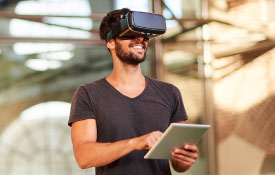The pandemic has reshaped entire retail landscape with immense changes. For instance, it forced many retailers to explore alternate paths when stores were closed, limiting the number of visitors to the stores. While change is inevitable, the pandemic has ensured that all of us are better-prepared for any eventuality.
This brings to fore an adage, ‘New challenges bring new opportunities.’ Specifically, retailers have propelled themselves well into the future by tapping into opportunities such as adopting immersive technologies, thereby accelerating digital shopping by roughly five years as per IBM’s 2020 US Retail Index Report. There is an upsurge in demand for artificial reality (AR) applications because of innovative use cases that have been made possible for global brands. The applications of AR for virtual try-ons and furnishing, for instance, have created a huge impact for brands looking to increase their brand value and adoption. During the pandemic, eCommerce took a giant leap - the share of online retail sales has grown to 19.5% in 2021 and is expected to grow to 25% in 2025 .
This dominance of online shopping is no surprise, given the adoption of technology across the world, further fueled by the pandemic. The interesting fact is that this has become launchpad for many global brands to prove their uniqueness in transforming the customer experience. Immersive technologies have become the choice for many of them to portray their customer connect. Having said this, it is not a straight dovetail joint to hammer on. This means that brands must entice the average consumer on par with the real environment, which brings in a significant amount of investment. The Return on Investment (RoI) may not be immediate, but is needed to survive in the game. Trends indicate that most brands adopt immersive technologies like AR and VR to improve CX. This is substantiated by the Statista report, which projects the market value for AR technology at over $18 billion by 2023.
Embracing the immersion:
The retail landscape is becoming more competitive, forcing players to keep pace. The pandemic is influencing buying behaviour and consumer decisions to an unprecedented extent. FirstInsight reports that consumers restrict themselves from visiting stores, fearing to try-out products in a trial room due to the pandemic. It was further discovered that 80% of women avoided trying beauty products, 68% avoided trying apparels in trial rooms and 61% avoided trying on shoes, citing safety concerns.
Brands are embracing immersive technologies to amalgamate boundaries between channels for their customers. They aspire to offer the same experience to orchestrate the customer journey. They also aim to embed technologies into stores, making the customers feel safe, elevating their experiences, and providing satisfaction of making an in-store purchase. In-store technologies also help them capture more nuanced data with leading insights. Needless to stress on the changes to be made for the future, Retail Dive’s bold statement, ‘mediocre retail has no future’ says it all.
Download Whitepaper to read more

